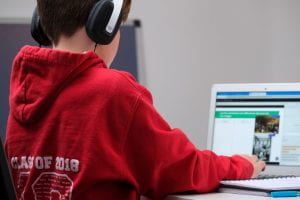
Photo by Compare Fibre on Unsplash
Working in a senior secondary public college, there is limited scope for embracing the latest trend in digital literacy or interactive media. A public school simply doesn’t have the funds, not is there space in the curriculum for much experimentation. With 30 weeks to teach 40 weeks worth of material and prepare students for exams, my experience has been not to get too clever. Working Padlet into my classes is about as inventive as I get.
What I do see is an increasing dependency on the mobile phone – not for learning but for distraction. Avoidance. There’s just so much going on in their lives, from relationship drama to sorting out a lift home to organising shifts at work. It’s hard to cut across that noise, so I’m not averse to integrating some form of digital learning – in the past I’ve tried student blogs, and creating memes, but these don’t have the same benefits of gamification, as described by Briggs (2016).
Their reference to the benefits of Minecraft in the classroom really highlighted for me the difference between what you can do in a primary school (or high school) setting, compared to a college. My son is in grade 6 and his teacher is using Minecraft almost every Friday morning to teach numeracy – but not just numeracy. Teams are given tasks, or challenges, to complete; doing so requires collaboration, maths skills and problem-solving, and then design and implementation followed by a reflection. Not only is my son super excited about being able to ‘play’ Minecraft with his friends in class, but he gets a chance to apply the learning in an engaging way.
Too often ‘engaging’ seems to mean ‘bells and whistles’, in digital device design. (There’s a nice bit of alliteration!) All those custom-made tablet-style devices for children, or the apps designed for them, seem to do little more than keep kids quiet. Some, like the ABC’s Reading Eggs (there’s also a maths version), are quite good at supplementing and consolidating more traditional classroom learning. The digital media mentioned by Springen (2011) are a lot more gimmicky than the publishers would like to admit. Which is why they haven’t ‘taken off’. There’s no substance to them. They’re not satisfying. You don’t get to sit with your thoughts, which we really need – our brains really need.

Photo by zhenzhong liu on Unsplash
Springen quotes several publishers as saying they don’t intend for digital media to replace print books; what’s not acknowledged is that young people are so distracted by shiny shiny, and getting so many dopamine hits from digital media/devices, that they’re not learning how to be present for a traditional book. It’s something that needs to be taught. My son’s primary school newsletter frequently includes messages about the importance of parents reading to their children from a young age, every. single. day. Digital media aims to free parents from this ‘chore’ and create a shortcut. But there isn’t one.
I’m generalising, of course. But that’s how we make a point. And my point is, it can’t be ‘digital media for the sake of digital media’. They’re not all equal. And just plopping a device in front of a kid doesn’t absolve adults from their responsibility to teach. There’s plenty of research on the benefits of print-based reading as opposed to digital, for learning comprehension especially (Delgado et al., 2018), as well as the potential harm caused by devices on children’s creativity (Ruder, 2019). Digital devices have a lot in common with TV shows like Cocomelon, which employs the same techniques to hook toddlers as poker machines do (Kosmas, 2022).
It must surely be about balance, and choosing digital media wisely and carefully. In terms of resourcing the library collection, I can see this being more difficult. Unlike books, Teacher Librarians can’t browse devices and apps with the same ease. And it’s not always obvious how a child will interact with it, or what exactly they will (really) learn. It will take a lot more work to research different digital media – and for teachers, more work to figure out how to integrate it in such a way that students actually learn something. They’re here to stay and so much has already changed; we do have a responsibility to teach children how to safely engage with and navigate digital and online spaces.
References
Briggs, S. (2016, Jan. 16). Using gaming principles to engage students. InformED. https://www.opencolleges.edu.au/informed/features/using-gaming-principles-to-engage-students/.
Delgado, P., Vargas, C., Ackerman, R. & Salmeron, L. (2018). Don’t throw away your printed books: A meta-analysis on the effects of reading media on reading comprehension. Educational Research Review, 25 (pp. 23-38). https://www.sciencedirect.com/science/article/pii/S1747938X18300101.
Kosmas, S. (2022, Mar. 17). Cocainemelon: Why toddlers can get addicted to watching Cocomelon. Evie. https://www.eviemagazine.com/post/cocainemelon-why-toddlers-can-get-addicted-to-watching-cocomelon.
Ruder, D.B. (2019, Jun. 19). Screen time and the brain. Harvard Medical School News & Research. https://hms.harvard.edu/news/screen-time-brain.
Springen, K. (2010, Jul. 19). The digital revolution in children’s publishing. Publisher’s Weekly. https://www.publishersweekly.com/pw/by-topic/childrens/childrens-industry-news/article/43879-the-digital-revolution-in-children-s-publishing.html.

















Leave a Reply